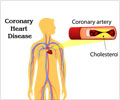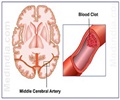Researchers have described a bioengineered enzyme function efficiently, that it has become a breakthrough drug for treating heart attacks and strokes.
Researchers at Oregon Health & Science University (OHSU) and Washington University in St. Louis have described the mechanism that makes a bioengineered enzyme function efficiently, paving the way for it to become a breakthrough drug for treating heart attacks and strokes.
The research team, led by Andras Gruber, M.D., associate professor of biomedical engineering and of medicine in the division of hematology and medical oncology, OHSU School of Medicine, explained how this genetically modified enzyme, known as WE-thrombin, works as a potent clot busting agent and still retains little of the power of thrombin.Thrombin is its non-engineered parent that has an opposite role that leads to a surge of clot building. In fact, ironically thrombin has the capacity both to promote and prevent blood clotting. While normal blood clotting is important for minimizing bleeding in the event of an injury; excessive clotting may cause thrombosis, the blockage of a blood vessel.
“The successful development of WE-thrombin would be a major medical breakthrough in antithrombotic therapy, ultimately saving thousands of lives worldwide each year,” said Gruber.
Two of the major causes of death, heart attacks and strokes usually result due to blood clots. This is because the drugs now relied on to stop or break up clots - such as heparin or TPA, tissue plasminogen activator pose the risk of triggering hard-to-control systemic bleeding.
According to the researchers, if it is approved for use in humans, WE thrombin could safely be injected by paramedics or others in case someone displays the first symptoms and signs of a stroke or heart attack without fear of causing harm if the symptoms prove to be a false alarm.
WE thrombin has already been shown to be effective and safe in large primates.
Advertisement
“What we’ve done recentlyis located the exact point where the catalytic reaction takes place in vivo that makes this molecule work as a superior antithrombotic agent,” added coinvestigator Owen J.T. McCarty, Ph.D.
Advertisement
The process then becomes self sustaining, or autocatalytic, implying that the glue is produced and reproduced in a rapid chain reaction. Thrombin subsequently counterbalances the process by activating protein C inside the blood vessel, which shuts down the autocatalytic reaction in the blood stream.
However, WE-thrombin, the mutant form of thrombin, does not have the ability to create the glue but still can produce activated protein C (APC) inside the blood vessels, which makes it a unique, locally acting anticoagulant.
It was discovered that the molecule enhances this ability by attaching itself to a receptor, or sticking point, called glycoprotein Ib (GPIb), located on the surface of platelets. In the process, WE-thrombin pushes aside and thus inhibiting the protein (the von Willebrand factor) that promotes coagulation, which now has to compete for the same receptor on the platelets.
Gruber said that because of WE-thrombin’s specificity and potency, the dosage required to be effective in humans, is expected to be less than 0.5 milligrams, and possibly less than 0.1 milligrams, or 200- to 1,000-fold less than the dosage levels of TPA commonly being given now in heart attack and stroke.
The study is published recently in Arteriosclerosis, Thrombosis, and Vascular Biology (ATVB), a peer-reviewed journal of the American Heart Association.
Source-ANI
SPH/L











